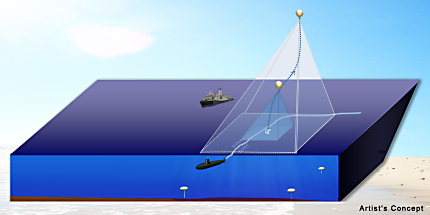In mapping future tech, DARPA cites drone, ISR success stories
In its biannual report envisioning future military systems, the agency also lauds one-time new technologies for their effectiveness.

An illustration of the Upward Falling Payload program.
It’s no secret that unmanned vehicles have been a godsend for the military. They do not put soldiers at risk, they are cheaper to operate than manned aircraft and they can maintain operation for hours, sometimes even days, without human interference depending on the level of autonomy. But as the United States begins to lose its edge in these systems, it must adapt and refine its development process.
That’s one conclusion from the Defense Advanced Research Projects Agency’s recently released biannual Breakthrough Technologies for National Security report, which highlights technological solutions and visions for maintaining the edge on the battlefield and other non-physical contested environments. While keeping an eye on future technologies, DARPA also underscored the success stories of unmanned vehicles and intelligence, surveillance and reconnaissance (ISR) capabilities.
Drones largely hit the popular consciousness starting with the wars in Iraq and Afghanistan, but their history as ISR systems dates back much further. DARPA notes that unmanned systems were “pioneered” in 1962 in both the air and sea domains. The QH-50 Drone Anti-Submarine Helicopter (DASH), developed by DARPA and the Navy at the time, “could carry antisubmarine torpedoes and gave destroyers the ability to attack enemy submarines far beyond the range of their antisubmarine rockets.” “Later,” DARPA continued, “DASH was equipped with television cameras for ISR purposes in Vietnam, where U.S. forces gave it the affectionate nickname ‘Snoopy.’”
DASH as an acronym is still around, in the form of underwater unmanned models, though the acronym now denotes a separate program than in 1962 – the Distributed Agile Submarine Hunting. DASH seeks to place devices on the ocean floor with the goal to track submarines until additional platforms can arrive or track them. DARPA compared DASH to satellites in space in terms of surveillance. “Just as satellites provide a wide-area view of the ground from space, these systems can see submarine threats passing overhead across vast volumes of ocean.” DARPA is currently testing undersea surveillance capabilities.
Additional underwater unmanned systems include the Upward Falling Payload program, which DARPA describes as a program that centers on “developing deployable, unmanned, distributed systems that could lie on the deep-ocean floor for years at a time. These deep-sea nodes could then be recalled remotely when needed and ‘fall upward’ to the surface. The goal is to support the U.S. Navy with distributed technologies anywhere over large maritime areas.”
ISR’s ability to locate, identify and track targets across vast distances and under any conditions is “vital to national security,” and unmanned systems have revolutionized these ISR missions, becoming a staple from the Cold War on, the report says.
The future of these programs must focus on continued transitions from research concepts to the branches of the military and command units. The ability to operate in contested environments—dealing with, for instance, radar, GPS or communications jamming—will be a big test for the future of unmanned systems and ISR, as other nations leverage increasingly available technological advances.
Among other key projects on the horizon, DARPA mentioned both the Tactically Exploited Reconnaissance Node (TERN) program and Aerial Reconfigurable Embedded System (ARES) program as examples of developmental systems to address deficiencies experienced in the battlefield to maintain tactical advantages. TERN seeks to shorten the runway requirements for aircraft similar to Reaper and Predator so they could be deployed and recovered by smaller ships. ARES aims to further eliminate the threat to flight teams by using unmanned vertical lift aircraft to deliver supplies and payloads or pick up casualties in hostile environments.




